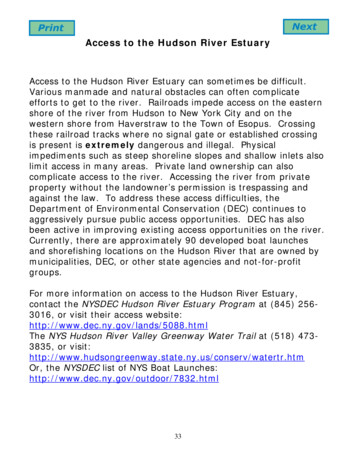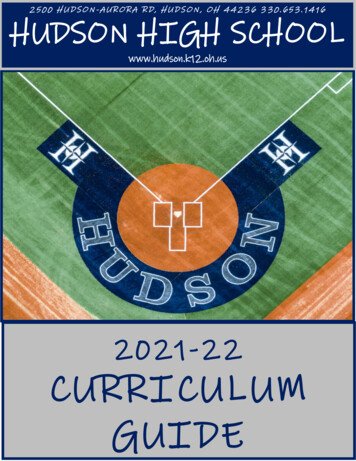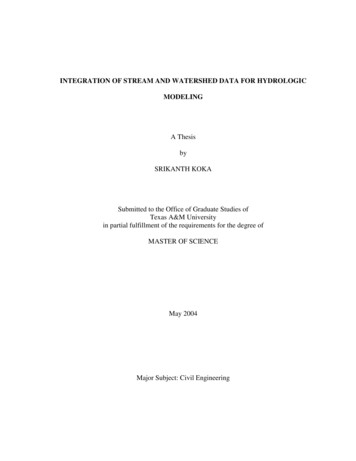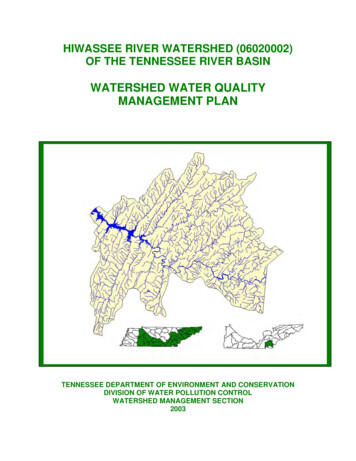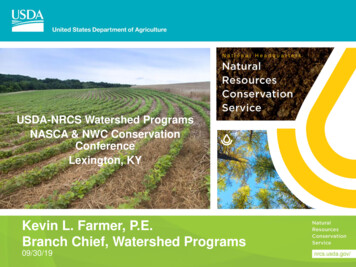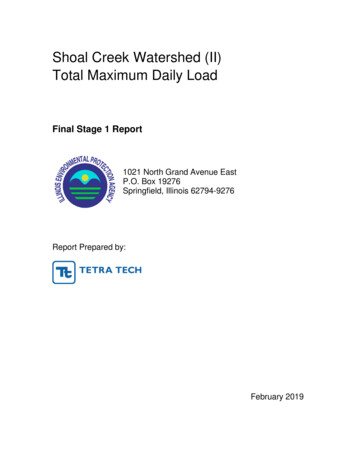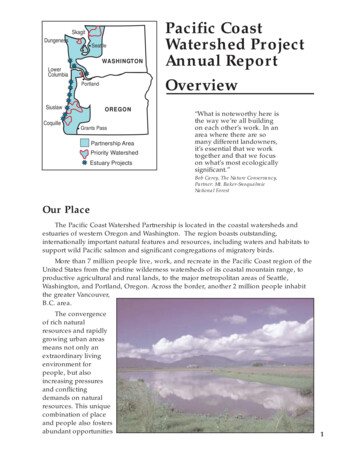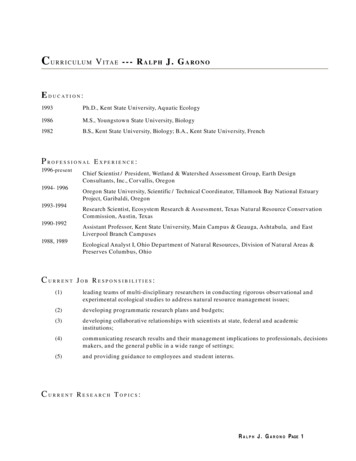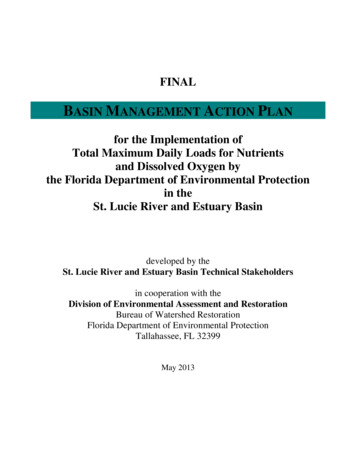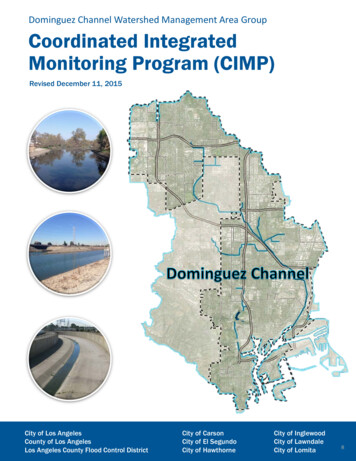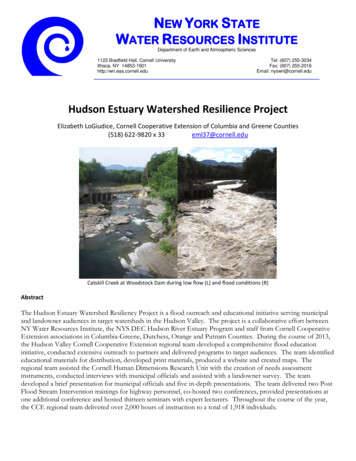
Transcription
NEW YORK STATEWATER RESOURCES INSTITUTEDepartment of Earth and Atmospheric Sciences1123 Bradfield Hall, Cornell UniversityIthaca, NY 14853-1901http://wri.eas.cornell.eduTel: (607) 255-3034Fax: (607) 255-2016Email: nyswri@cornell.eduHudson Estuary Watershed Resilience ProjectElizabeth LoGiudice, Cornell Cooperative Extension of Columbia and Greene Counties(518) 622-9820 x 33eml37@cornell.eduCatskill Creek at Woodstock Dam during low flow (L) and flood conditions (R)AbstractThe Hudson Estuary Watershed Resiliency Project is a flood outreach and educational initiative serving municipaland landowner audiences in target watersheds in the Hudson Valley. The project is a collaborative effort betweenNY Water Resources Institute, the NYS DEC Hudson River Estuary Program and staff from Cornell CooperativeExtension associations in Columbia-Greene, Dutchess, Orange and Putnam Counties. During the course of 2013,the Hudson Valley Cornell Cooperative Extension regional team developed a comprehensive flood educationinitiative, conducted extensive outreach to partners and delivered programs to target audiences. The team identifiededucational materials for distribution, developed print materials, produced a website and created maps. Theregional team assisted the Cornell Human Dimensions Research Unit with the creation of needs assessmentinstruments, conducted interviews with municipal officials and assisted with a landowner survey. The teamdeveloped a brief presentation for municipal officials and five in-depth presentations. The team delivered two PostFlood Stream Intervention trainings for highway personnel, co-hosted two conferences, provided presentations atone additional conference and hosted thirteen seminars with expert lecturers. Throughout the course of the year,the CCE regional team delivered over 2,000 hours of instruction to a total of 1,918 individuals.
Hudson Estuary Watershed Resiliency ProjectMajor AccomplishmentsMunicipal Presentations - The Hudson Valley Cornell Cooperative Extension team developed a brief presentationfor municipal officials that provided key messages related to streams and flooding. The team researched andidentified fact sheets and resources to include in a folder of information that was distributed during the briefpresentations. In 2013, the Hudson Valley CCE team provided 88 brief presentations to Town and County boardson flood resiliency.Seminar Series & Conferences – The Hudson Valley Cornell Cooperative Extension team organized and hostedthirteen seminars on a variety of topics, including the FEMA National Flood Insurance Program, Dam Safety, HowWetlands and Forests Reduce Flood Risk, Scenic Hudson’s Sea Level Rise Mapper and Streams 101. The seminarswere held throughout the Hudson Valley. The Cornell Cooperative Extension team planned or providedpresentations at three conferences, partnering with a variety of organizations, including the Hudson RiverWatershed Alliance and Cary Institute of Ecosystem Studies.Post Flood Stream Intervention Trainings – The Hudson Valley Cornell Cooperative Extension team initiated acollaborative approach to offering the NYS DEC’s new Post Flood Stream Intervention Trainings in the HudsonValley. Cornell Cooperative Extension staff coordinated planning of the training with a wide variety of partners,including NYS Department of Environmental Conservation, NYC Department of Environmental Protection,Natural Resource Conservation Service and the Lower Hudson Coalition of Conservation Districts. Two trainingswere developed and delivered in 2013 to an audience of town and county highway personnel and agency staff. Thetwo-day trainings included a day of classroom instruction and a day of experience in the field at flood damaged sites.The trainings were offered in Greene County, in partnership with Greene Soil and Water Conservation District(SWCD) and in Dutchess County in partnership with Dutchess SWCD.NYSWRI0904132
Hudson Estuary Watershed Resiliency ProjectIntroductionBackground and project need, audiences and relevanceExtreme weather, such as Tropical Storms Irene andLee, and Hurricane Sandy have pointed out the needfor communities to become more ready to respondeffectively to flood events. The Hudson EstuaryWatershed Resiliency Project (HEWRP) wasestablished to deliver educational messages regardingflood readiness, stream dynamics and flood responsein streams to audiences in the Hudson Valley.The audience for the HEWRP is municipal officials,highway personnel and landowners in targetwatersheds in the Hudson Valley.Although flood risk in the Hudson Valley is a longstanding issue, an increase in very heavy precipitationevents is creating a greater need for communities todevelop a more resilient approach to flood readinessand response. A needs assessment conducted by theCornell Human Dimensions Research Unit and theHudson Valley Cornell Cooperative Extension teampoints to the relevance of this project to communitiesin the Hudson Valley. The assessment indicates thatwhile many municipal officials understand that floodrisks are increasing, most communities are not yetaddressing vulnerabilities to flooding. Furthermore,post flood response in streams after Tropical StormsIrene and Lee were often well-intentioned but poorlyexecuted, which points to a need for greaterunderstanding of fluvial geomorphology in targetaudiences. This project is relevant from a perspectiveof promoting community well-being and readiness, aswell as protecting the integrity and functioning ofstream systems in the Hudson Estuary watershed.Program DescriptionPartners & collaborators, key elements of program,project goal(s), geographic area served by project (ifapplicable).During 2013, the Hudson Valley Cornell CooperativeExtension (CCE) regional team developed acomprehensive flood outreach initiative, anddelivered educational programs to target audiences.CCE of Columbia & Greene counties coordinated theeffort to plan and deliver the HEWRP, working inpartnership with CCE associations in Dutchess,Orange & Putnam counties, NYS Water ResourcesInstitute (WRI), the Hudson River Estuary Program,Cornell University and many other partners.Collaborators included Lower Hudson Coalition ofConservation Districts, NYC Department ofEnvironmental Protection, NRCS, USGS, NYS DECOffice of Floodplain Management and Dam SafetyDivision and others. The CCE team collaboratedwith the Cornell Human Dimensions Research Unitto conduct needs assessments with municipal andlandowner audiences.Key elements of the program included a needsassessment and extensive outreach to municipalofficials and highway personnel on topics related tostreams and flooding. Outreach methods includedseminars, conferences, presentations, trainings, printmaterials and website development.The project goal is to develop capacity in HudsonValley municipal officials, highway personnel, andriparian landowners to implement watershedresiliency strategies to minimize future floodingimpacts, while also properly responding to stormimpacts to streams and adjacent and associatedinfrastructure.The geographic area served by this regional projectincluded target watersheds in Albany, Columbia,Dutchess, Greene, Orange, Putnam, Rensselaer,Schoharie and Ulster counties.Project MethodsNeeds assessment (if applicable), audiencecharacterization, literature review, educationalmaterials development or adaptation, types of outreachemployed in the project.The CCE regional team assisted the Cornell HumanDimensions Research Unit (HDRU) with the creationof needs assessment instruments for municipalofficials and landowners. CCE staff received IRBtraining and conducted interviews with municipalofficials in the Hudson Valley. Thirty-seveninterviews were conducted in total. The CCEThis report was prepared for the New York State Water Resources Institute (WRI) and the Hudson RiverEstuary program of the New York State Department of Environmental Conservation, with support from theNYS Environmental Protection Fund.
Hudson Estuary Watershed Resiliency Projectregional team provided GIS and other support toHDRU on the landowner survey, which was sent to2,000 streamside property owners in the HudsonValley.An extensive literature review was conducted, withstaff from the Estuary Program, WRI and CCEcontributing materials on stream stewardship, streamdynamics and flood resiliency to a Cornell Boxlocation. Literature distributed to audiences weregleaned from the Cornell Box files.The CCE team developed outreach materialsincluding a project executive summary, tri-paneldisplay, landowner flood preparedness documentsand a website www.hudsonestuaryresilience.net. Theteam created GIS maps to help with the delivery ofeducational efforts. Lower Hudson Coalition ofConservation Districts produced a Municipal FloodGuide, working under a sub-contract with CCEColumbia-Greene.The CCE team developed several presentations,including a brief presentation for town boards, athirty minute presentation on the project, a one hourpresentation on forests and flood resiliency, and a 1.5hour stream dynamics presentation. The teamworked with partners to adapt the NYS DEC PostFlood Stream Intervention Training into a two dayworkshop, which was delivered in Greene andDutchess counties. The team delivered 88 briefpresentations to town board and county officials andhosted thirteen seminars on a variety of topics,including culvert sizing, forests and wetlands forflood management and FEMA National FloodInsurance Program. The team participated inplanning two conferences and provided presentationsat three conferences. The tri-panel display wasexhibited at 11 events, including county fairs. TheCCE team recruited participants and volunteers forthree Trees for Tribs plantings on flood damagestream banks and conducted one landowner outreachevent.Impacts and Results Numbers served, knowledgegained, behavior changes, audience feedbackOver the course of 2013, the Hudson Valley CCEregional team delivered over 2,000 hours ofinstruction to a total of 1,918 individuals.The Hudson Estuary Watershed Resiliency Projectwas very well received by target audiences.Evaluations conducted with program attendeesconsistently showed increase in knowledge andattendees indicated that they found the programs tobe worthwhile experiences. Quotes from programattendees were very positive. The following quotesare a few of the responses to the question: Please list atleast one (or more) concrete action(s) you will take as a result ofthis workshop.From the Flood Management: New Strategies in a ChangingClimate Forum:“I will continue to look for (and attend) othereducational workshops/forums like this to learn howmunicipalities are handling the issue of climatechange.”{I will} “Encourage my town to re-do itscomprehensive plan. As chair of planning board, I'llinsist all board members become familiar with thisissue.”From the Post Flood Stream Intervention Trainings:“Not to be so quick to rip and tear with bulldozer andexcavator.”“Try to get stream bed back to its original space. Trynot to dredge or use berms to control water flow.”“Not use gravel berms as a flood control structure.”Evaluation of the Post Flood Stream InterventionTraining was conducted in partnership with CornellHDRU and an article on the results was published inthe Journal of Extension (see References).Policy ImplicationsDiscuss policy implications of your outreach. Describehow this outreach interfaces with existing and proposedlaws/regulations or community actions.This report was prepared for the New York State Water Resources Institute (WRI) and the Hudson RiverEstuary program of the New York State Department of Environmental Conservation, with support from theNYS Environmental Protection Fund.
Hudson Estuary Watershed Resiliency ProjectPotential long-term policy implications of theHEWRP include changes to zoning and code toinclude wetland and riparian buffer ordinances, andwiser floodplain management and post floodresponse in streams. Policies regarding stormwatermanagement, participation in the FEMA CommunityRating System and placement of roadwayinfrastructure near streams may also be impacted overthe long term.References:Allred, S., Gary, G., and LoGiudice, E. 2014 AnExtension Education Program to Help LocalGovernments with Flood Adaptation. Journal ofExtension 52 ices (if needed)This report was prepared for the New York State Water Resources Institute (WRI) and the Hudson RiverEstuary program of the New York State Department of Environmental Conservation, with support from theNYS Environmental Protection Fund.
the Hudson Valley Cornell Cooperative Extension regional team developed a comprehensive flood education initiative, conducted extensive outreach to partners and delivered programs to target audiences. . Cornell University Tel: (607) 255-3034 Ithaca, NY 14853-1901 Fax: (607) 255-2016 . including a project executive summary, tri-panel display .

